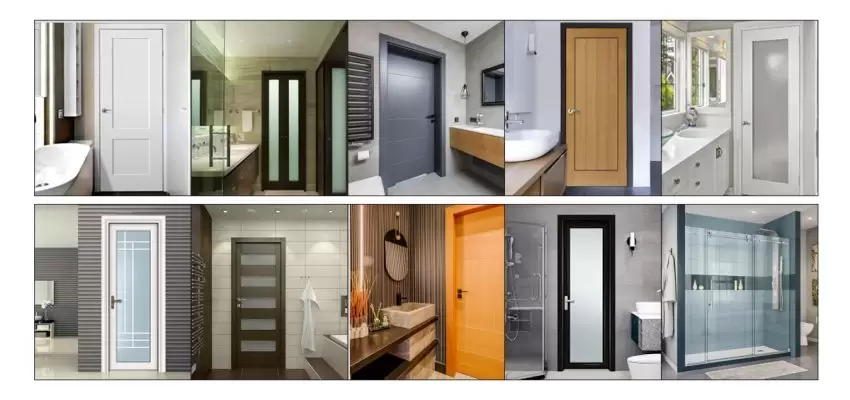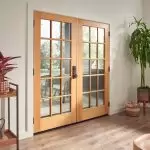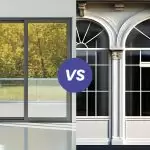Bathroom door designs can help enhance the look of your bathrooms and also increase the appeal of the interior of your properties. This addition can make your interiors look more modern, attractive and complete. Deciding on a bathroom door design, however, is something that becomes difficult as not many are aware of how one should select a bathroom design that matches your interior style. This blog provides you with multiple different bathroom door designs to streamline the process of selection and make it easier for you to complete the building of your properties.
Post your Requirement
Factors that Affect the Optimum Door Design for Your Bathroom
Space and Layout
- Size: The size of your bathroom becomes an important factor that decides what kind of door design you should opt for. For example, for smaller bathrooms, sliding doors are suggested as they reduce the waste of space due to the swinging door.
- Door Swing: Whether the door should swing in or out also becomes a decision that some overlook. This decision is affected by the placement of fixtures and furniture inside the bathroom and the exterior of the bathroom.
Style and Aesthetics
- Interior Design: The bathroom door should suit the overall interior design style of your property. It can be modern, traditional or eclectic. The door design should be selected that highlights the pre-existing style of the property instead of seeming completely out of place.
- Material: There are different materials for the bathroom doors that can range from wood, glass, metal to PVC. Each material has its own positives and negatives, which will be further discussed in detail below.
Functionality
- Storage: Some door designs can be improvised to be more useful than a mere door. Some doors provide an option to store toiletries, clothes, etc., to help save space and maximise the available space.
Safety and Accessibility
- Childproofing: To make the place more child-friendly, consider doors that are simple to open and close to prevent incidents.
- Accessibility: For people with mobility issues, sliding or pocket doors can be a better choice than traditional swinging doors.
Budget
- Cost: The cost becomes a major factor when deciding the type of design for your bathroom door. Different materials have different costs of acquiring and maintenance which should be considered beforehand to ensure that this does not become an expensive affair.
Maintenance
- Ease of Cleaning: Bathroom doors are more prone to become a growing ground for fungi and other bacteria. Hence, ease of cleaning becomes a crucial aspect to consider. Some materials and designs make it easier to clean than others. For example, glass doors may require more frequent cleaning to maintain clarity and wooden doors can hold onto moisture which makes it more prone to the growth of bacteria and even mold.
Types Of Bathroom Design
Bathroom doors are often considered to be entirely functional elements that are needed to ensure the privacy, comfort, and hygiene of the spaces. However, they are the critical components of the overall ambiance and feel of the interiors, with stylish design options and tempting looks. We have gathered here some of the most popular and modern bathroom door design ideas to help you build your bathroom with comfort and style.
Bathroom Doors Based on Material
1. PVC Bathroom Door Designs
The PVC bathroom door designs are among the top choices for bathroom spaces due to their superior resistance to moisture and affordability standards. The PVC bathroom doors are incredibly lightweight and ensure ease of installation, along with catering to the diverse aesthetic needs of people. The variety of colour and pattern options and their low maintenance needs, even with constant exposure to moisture and humidity, make them a practical and cost-effective choice in the long run. Whether you aim to create a strong statement with bold, vibrant hues or create a serene, calm feel with softer, neutral tones, PVC is ideal for extreme customisation options.
2. Glass Bathroom Door Designs
If you want a sleek and modern look in your interiors with a touch of luxury and elegance, glass bathroom doors are the go-to option. You can go for frosted or textured glass, as they are the advanced options that ensure the necessary privacy in spaces while allowing light to pass through, thereby making even the small bathrooms appear larger and brighter. They need to be professionally installed for safety and performance, but are quite easy to clean and maintain in the long run. They will add a critical sense of sophistication to your spaces.
3. WPC Door Designs for Bathroom
WPC bathroom doors, as the name suggests, refer to a kind of door design that is built with a blend of wood fibres and plastic, carrying the natural and timeless appeal of the material of wood along with the moisture resistance, strength, and resilience of plastic. The WPC doors are eco-friendly structures that come with features like termite resistance, durability, and an attractive aesthetic appeal that ensures suitability in every structure, ranging from mid to high-end spaces. They are minimal maintenance structures that can withstand the humid conditions of bathrooms and ensure long-term reliability with excellence.
4. Aluminium Door Designs for Bathroom
Aluminium is a material known for its durability and strength, ideal for high-traffic spaces like bathrooms where moisture resistance is a must. Aluminium is a lightweight material that ensures premium features like ease of installation, resistance to rust and corrosion, and a low-maintenance benefit that ensures efficiency in structures. You can also get the structures combined with frosted or laminated glass panels for a minimalist yet attractive design. You can customise the aluminium bathroom doors to make them highly attractive with superior functionality and long-term reliability.
5. uPVC Door Designs for Bathroom
A significantly more durable material as compared to PVC, uPVC is a rigid and sturdy form of plastic that is widely used for the manufacturing of long-lasting and high-performing door designs. They come with an effective resistance to rust and corrosion and ensure features like insulation properties with incredible resistance to moisture, steam, termites, and other potential concerns. They are built with longevity in mind and are excellent for bathroom door designs due to their attractive appeal, along with low maintenance needs.
6. High-Grade Wooden Door Design for Bathrooms
The wooden doors come with the natural warmth and timeless appeal of the natural materials that ensure a unique beauty and luxurious grace to the spaces. You can go for options such as teak, BWP (Boiling Water Proof) plywood, as they are treated with waterproofing agents or laminates for the moisture resistance properties that are basic to the bathroom doors. The laminates help prevent the door’s warping and swelling and impart longevity in structure, thereby making it a great choice for high-end spaces.
Bathroom Doors Based on Design
1. Bi-Fold Washroom Door Design
The bi-fold doors are some of the most popular choices for the washroom or toilet door design due to their ability to ensure a space-saving approach along with smooth operation and long-term performance. The bi-fold refers to the kind of door designs that fold inwards or outwards along a pre-defined track that ensures easy and smooth access to the spaces with a stylish look of interiors. You can use these for bathroom closets, shower partitions, and other spaces, particularly in compact areas.
2. Panelled Modern bathroom door design
If you want something unique and charming in its way for your bathroom doors, the panelled bathroom door design is the way to go. These structures feature a classic look with several rectangular or square panels embedded into the surface. The panels are often made with wood, steel, or composite materials and serve to be decorative elements that work well with traditional or colonial style interiors. They can sense depth and texture, making your spaces eye-catching and comforting for all.
3. Sliding Door design for bathroom
The sliding doors prove to be the best choice for the compact bathroom designs that rule the landscape of most of our houses. The sliding doors come with gliding mechanisms that eliminate the need for extra clearance space like in casement doors and prove to be a lavish, elegant, and highly functional option for compact spaces. Particularly ideal for contemporary homes or small apartments, sliding bathroom doors can create a sense of openness and a bright feel, along with an enhanced visual appeal.
4. Elegant Pocket Doors for Bathrooms
A variation of the sliding doors, pocket doors have made a comeback in the industry in recent years with their space efficiency, quality look, and strong ability to captivate the audience. You can go for stylish designs of pocket doors for small bathrooms or the toilets with cramped layouts, as they do not require any extra clearance space for movement and create a luxurious look of minimalism with high standards of privacy and practicality in spaces. They are also excellent products for creating rich interiors with unique elements.
5. French Bathroom Door Designs for Captivating Indoors
The French doors have been part of the Indian household and the Indian lifestyle for a long time. French doors are large door designs that can adorn the beauty of the large interior designs due to their elegant look and a grace of richness. These are the double doors that are hinged on the side and open from the centre either inwards or outwards, based on the overall design. They can be customised to a variety of colours and styles based on your personal needs and can elevate your overall lifestyle with ease of use and tempting beauty.
6. Latest Bathroom Door Designs with a Full-Length Mirror
We all wish to have a full-length mirror in our bathrooms for us to adorn ourselves and check out how our outfits suit us. This is why the mirrored bathroom designs are the new trend that tempts us all. This is a sleek design that comes with a stylish frame and built-in mirror panels that add depth, character and create an illusion of space in the interiors. You can use it for grooming or just for creating brighter indoors, especially effective in small or dimly lit spaces. This is the perfect bathroom door design for you if you have a knack for mirror selfies.
What Should Be The Toilet Door Direction As Per Vastu Shastra?
Most of us consider Vastu Shastra while deciding the layout of the homes, placement of the different furniture elements, and others. Therefore, we should do a careful consideration of the Vastu Shastra for the direction and opening of the bathroom doors to ensure positive flow in the interiors without compromising on style. Some of the essential Vastu tips for bathroom door directions include the following:
Door Direction
- The bathroom doors should be in the north, east, or northeast direction, as these directions are considered to be auspicious and ensure a flow of positive energies in the spaces.
- You should avoid placing the doors directly opposite to the bed or kitchen as it is believed to bring a sense of negative energies in the living spaces.
Toilet Door Opening Direction
- The toilet doors should open inwards and preferably towards the left when one enters.
- You should always keep the bathroom door closed to help prevent the negative aura and energies from spreading in diverse areas of the house.
Material and Colour of the Door
- You should avoid the use of iron for your bathroom doors as they are prone to rusting and corrosion with exposure to water, thereby affecting the whole aura of the space.
- Wooden doors are the most preferred choice for the bathroom doors as they are known for their positive energies and warmth that create a sense of comfort in spaces.
- You should avoid the use of black or red colored doors and go for light, earthy, or pastel shades for the bathroom doo that are considered Vastu-friendly.
Additional Tips
- You need to keep your bathroom doors well-maintained. You should regularly repair or replace the old ones.
- You should avoid placing the toilet door in the centre of the wall, especially if the bathroom shares a wall with the bedroom.
Choose the Right Bathroom Design for Maximum Privacy and Performance
There are a plethora of options in the industry when it comes to bathroom door styles and designs. You should not neglect the fact that the bathroom doors are essential components of the overall decor and look of your interiors and thus choose the right look and functionality carefully. You can choose anything from the wooden doors to steel or aluminium doors, just consider your personal preferences, resistance to moisture and go for a reputable bathroom door manufacturer for maximum performance.
FAQ’s
Q-1 How to obscure the presence of a bathroom door?
A-1 To do this effectively, you would need to take into account what kind of design is used on the walls, particularly on the same side as the door. Now, use a material that can effectively replicate that design so that it can hide in plain view. You can also eliminate the need for a handle by using a sliding or pocket door, which further enhances the effect one might have.
Q-2 What affects the price of the door?
A-2 The price of the door is affected by a list of factors as defined below:-
- Cost of Material.
- Dimensions of The Door.
- Mechanism of The Door.
- Cost of Maintenance.
- Frequency of Maintenance.
Q:3 Which door is suitable for a toilet?
A:3 You should go for moisture-resistant door options such as the material of PVC, uPVC, fibreglass, aluminium, or the laminated doors that ensure long-term performance and reliability with negligible concerns of warping or swelling due to humidity.
Q:4 Do you need a special door for a bathroom?
A:4 You need a special door for your bathroom spaces as the spaces are constantly exposed to moisture and humidity, and thus the use of moisture-resistant materials is a must. You should go for durable and preferably lightweight structures with superior ventilation features for prevention of molds and other concerns.
Q:5 What is the average cost of a bathroom door?
A:5 The average cost of the bathroom doors varies based on the style, material choice, supplier, and numerous other factors. The estimated costs can be estimated as follows:
- PVC doors: ₹1,500 – ₹4,000
- uPVC doors: ₹3,000 – ₹8,000
- Flush doors with waterproof laminate: ₹2,500 – ₹6,000
- Premium options (glass, designer panels, etc.): ₹7,000 and above
Q:6 Is a PVC door good for a bathroom?
A:6 Yes, the PVC doors serve to be great choices for a bathroom as they are unbelievably affordable and are waterproof, termite-proof, lightweight by nature, and easy to install. You can also customize them for a rich look.























Post A Comment